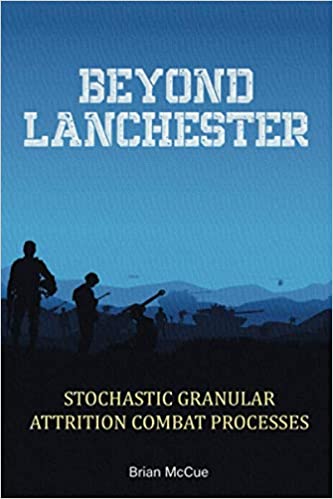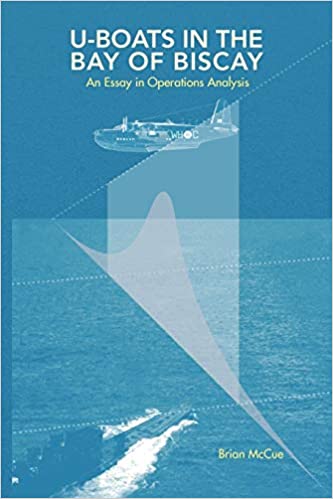
The publication of the book Beyond Lanchester last year had escaped me. See Beyond Lanchester: Stochastic Granular Attrition Combat Processes
His blurb on the book:
F.W. Lanchester famously reduced the mutual erosion of attrition warfare to simple mathematical form, resulting in his famous “Square Law,” and also the “Linear Law.” Followers have sought to fit real-world data to Lanchester’s equations, and/or to elaborate them in order to capture more aspects of reality. In Beyond Lanchester, Brian McCue–author of the similarly quantitative U-Boats In The Bay Of Biscay–focusses on a neglected shortcoming of Lanchester’s work: its determinism. He shows that the mathematics of the Square Law contain instability, so that the end-state it predicts is actually one of the least likely outcomes. This mathematical truth is connected to the real world via examples drawn from United States Marine Corps exercises, Lanchester’s original Trafalgar example, predator-prey experiments done by the early ecologist G.F. Gause, and, of course the war against German U-boats
This is an in-depth discussion of the subject of the use Lanchester equations by Dr. Brian McCue, previously of CNA (Center for Naval Analysis) and OTA (Congressional Office of Technology Assistance). We have also posted and written before about Lanchester (see War by Numbers). Some of our old blog posts on Lanchester are here:
Lanchester equations have been weighed…. | Mystics & Statistics (dupuyinstitute.org)
TDI Friday Read: The Lanchester Equations | Mystics & Statistics (dupuyinstitute.org)
The Lanchester Equations and Historical Warfare | Mystics & Statistics (dupuyinstitute.org)
The book is 121 pages. The Table of Contents for Brian McCue’s book includes:
Introduction
Lanchester’s Theory
A New Look At Lanchester
Trafalgar
Subsuface Combat in a Test Tube
Weaknesses of the Deterministic, Continuous-Variable Approach
A Probabilistic, Event-Driven Revision of Gause’s Work
Theory and Experiment
Implications for Military Operations Research
Applying Hughes’s “Salvo Equations” to Engagements between U-Boats and Convoy Escorts
Wartime Analysis
Using Simulated Annealing to Solve a Problem of “Ecological” inference
Results
Back to Attrition: The Salvo Equations
Results: Fitting HESSE to the North Atlantic Data
Goodness-Of-Fit
Final Thoughts
Anyhow, having just discovered it, I have not read it yet. Brian McCue is an old friend of mine and previously published U-Boats in the Bay of Biscay. See: U-Boats in the Bay of Biscay: An Essay in Operations Analysis

I found CDB13 is a dataset based on HERO. When I use this dataset, I find this dataset is hard to use.The data is not only subjective, but also has some isolated point(such as -9). I tried to reproduct the results in your book War by numbers, but it was failed. Using logistic regression, I found the FFR has little influence on the probability of win. So why this happened? The dataset is wrong or I used a wrong model?
I don’t use the CDB13 data set (also known at CDB90…as it was issued out in 1990). It was originally developed by us in hard copy (paper) as the LWDB. CAA then took ownership of it and programmed it, which included some data entry errors.
In the meantime, we did some minor revisions and updates to the LWDB, programmed it as a Reflex Data Base (around 1989). I then took the programmed LWDB and had it programmed it in Excel (around 1995), which allowed us to include the narratives of the battles in the data base (which are not in the CDB13). I then updated, restructured, expanded and revised the database. Our last major work on the database was for Situational Awareness study we completed in 2004. It is twice the size of the CDB13 database.
See: http://www.dupuyinstitute.org/dbases.htm
But these pages also need to be updated. For example the DLEDB now consists of 752 engagements. We also have a company-level database. This is all discussed in various footnotes in War by Numbers.
By the way, what exactly did you test and what is “FFR”?
Thanks for your reply. FFR-Force to Force Ratio, FSR-Force to Space Ratio. Biddle and other literatures use these terms.
Yes, I do have some graphs of force ratio (strength ratio) versus loss ratio in chapter 9. My discussion on force ratios was just a simple statistical comparison. I did not graph it. I could of, I just didn’t see a reason to.
But, to show you the difference in data sets, Table 2.3 is built from a set of ETO engagements that are at least twice the size of what is in CDB13. Tables 2.4 and 2.5 are built from almost all new engagements that were not in CDB13. Table 2.6 is mostly built from new engagements. So, I forget how many division-level engagements were in CDB13 (300 maybe?), but this is a database we have expanded greatly, at least doubled (752 division-level engagements). Some of the engagements were developed from our three urban warfare studies, some were developed for our Situational Awareness study, and we also added a “complete” collection of 1991 Gulf War engagements. For that last effort we contracted someone with proper background and knowledge and paid for it out of our own pocket (officially The Dupuy Institute’s R&D funds).
In the bigger picture, we have always appreciated the power of a well-developed rigorous combat data base and have worked independently to fully develop one. We have asked for government support for this several times, but they have never shown an interest in further developing this. They did pay for the original LWDB in paper version back in the late 1980s, and then separately programmed the database (in 1990). They have done nothing with it since then. We have done a whole lot more since then to develop these data bases (as I also have battalion-level and company-level databases). It was on our own time and expense. The U.S. government has never expressed a serious interest in acquiring it.